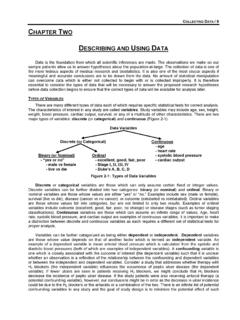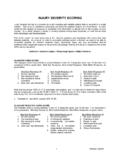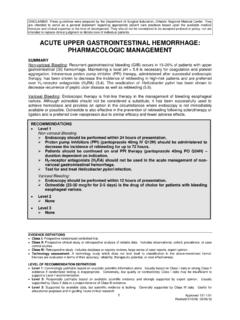Transcription of STRESS ULCER PROPHYLAXIS - SurgicalCriticalCare.net
1 DISCLAIMER: These guidelines were prepared jointly by the Surgical Critical Care and Medical Critical Care Services at Orlando Regional Medical Center. They are intended to serve as a general statement regarding appropriate patient care practices based upon the available medical literature and clinical expertise at the time of development. They should not be considered to be accepted protocol or policy, nor are intended to replace clinical judgment or dictate care of individual patients. EVIDENCE DEFINITIONS Class I: Prospective randomized controlled trial. Class II: Prospective clinical study or retrospective analysis of reliable data.
2 Includes observational, cohort, prevalence, or case control studies. Class III: Retrospective study. Includes database or registry reviews, large series of case reports, expert opinion. Technology assessment: A technology study which does not lend itself to classification in the above-mentioned format. Devices are evaluated in terms of their accuracy, reliability, therapeutic potential, or cost effectiveness. LEVEL OF RECOMMENDATION DEFINITIONS Level 1: Convincingly justifiable based on available scientific information alone. Usually based on Class I data or strong Class II evidence if randomized testing is inappropriate. Conversely, low quality or contradictory Class I data may be insufficient to support a Level I recommendation.
3 Level 2: Reasonably justifiable based on available scientific evidence and strongly supported by expert opinion. Usually supported by Class II data or a preponderance of Class III evidence. Level 3: Supported by available data, but scientific evidence is lacking. Generally supported by Class III data. Useful for educational purposes and in guiding future clinical research. 1 Revised 1/15/2004, 12/7/2005, 10/11/2009, 9/15/ 2011 , 11/2/2017 STRESS ULCER PROPHYLAXIS SUMMARY The incidence of clinically important gastrointestinal bleeding due to STRESS ulceration has declined with advances in the resuscitation and management of critically ill patients.
4 Maintaining adequate systemic perfusion and initiating early enteral nutrition play a significant role in preventing STRESS ulceration. The efficacy of histamine-2 receptor antagonists (H2 RAs), antacids, and proton-pump inhibitors (PPI) in preventing STRESS ulceration remains controversial. PROPHYLAXIS using these medications is associated with potential adverse effects and drug interactions as well as additional cost. Given the controversial efficacy of these agents, their use should be limited to patients with acute risk factors. In addition, these guidelines are not intended for patients that have an indication for treatment with acid suppressive therapy, such as duodenal ULCER disease, gastroesophageal disease, etc.
5 RECOMMENDATIONS Level 1 None Level 2 Chemoprophylaxis for STRESS ULCER prevention is indicated in patients with acute risk factors. Discontinue therapy when patients no longer have acute risk factors. Consider discontinuing therapy when a patient is tolerating full enteral feeding. Sucralfate is an acceptable alternative to a H2RA and may decrease the incidence and severity of ventilator associated pneumonia. A PPI is an alternative to a H2RA or Sucralfate in situations where these agents cannot be used. Level 3 A H2RA can be considered in patients that are NPO and have at least two potential risk factors for STRESS ulceration.
6 Acute Risk Factors for STRESS Ulceration Mechanical ventilation (>48 hours) without enteral nutrition Coagulopathy Hypoperfusion (shock, or organ dysfunction) High-dose corticosteroids (>250 mg/day hydrocortisone or equivalent) Significant burn injury (total body surface area 20%) Potential Risk Factors for STRESS Ulceration Concomitant use of a non-steroidal anti-inflammatory drug (NSAID) Concomitant or recent corticosteroid use History of upper gastrointestinal (GI) hemorrhage, peptic ULCER disease, or gastritis 2 Revised 1/15/2004, 12/7/2005, 10/11/2009, 9/15/ 2011 , 11/2/2017 INTRODUCTION STRESS ulceration is a form of hemorrhagic gastritis that may occur following trauma or critical illness (1).
7 Although not completely understood, the pathophysiology is likely multifactorial. Inadequate systemic perfusion resulting in poor mucosal blood flow, and reperfusion injury play an important role in the development of STRESS ulceration (1,2). Decreased gastric pH, increased mucosal permeability, and alterations in normal protective mechanisms may also be contributing factors (2,3). There has been a decrease in the incidence of clinically important bleeding due to STRESS ulceration (1). This can likely be attributed to improved resuscitation, earlier initiation of enteral feeding, the cessation of high dose steroids for traumatic brain and spinal cord injury, and possibly the use of pharmacologic PROPHYLAXIS .
8 Medications used for STRESS ULCER PROPHYLAXIS act by inhibiting gastric acid secretion, neutralizing gastric acid, or protecting the gastric mucosa. The efficacy of H2 RAs and antacids has been extensively studied. Both placebo-controlled trials and meta-analyses, however, have yielded conflicting results (2). Similarly, PPIs for STRESS ULCER PROPHYLAXIS have been evaluated in a limited number of published trials. Although these agents effectively maintain gastric pH 4, this endpoint has not been proven to improve clinical outcome. Additionally, superiority over H2 RAs has not been demonstrated in a well-designed trial. Many investigators now question the value of pharmacologic PROPHYLAXIS , especially in the setting of improved resuscitation techniques and early enteral feeding.
9 A randomized, controlled trial that compared a PPI, H2RA, and sucralfate with placebo in 287 high-risk trauma/surgery patients demonstrated no difference in clinically significant upper GI bleeding with percentages of 1%, 3%, 4%, and 1%, respectively (4). Prophylactic medications are associated with potential adverse effects such as increased risk of Clostridium difficile infection and ventilator associated pneumonia, and drug interactions as well as additional cost. LITERATURE REVIEW Risk Factors for STRESS Ulceration In a multicenter study of 2252 patients, Cook et al. identified respiratory failure (mechanical ventilation for at least 24 hours) and coagulopathy (platelet count <50,000 mm3, INR > , or aPTT > 2 times control) as independent risk factors for bleeding (5).
10 Of the 33 patients ( ) with clinically important bleeding, 23 (70%) were receiving STRESS ULCER PROPHYLAXIS . However, the use of PROPHYLAXIS was not controlled and various regimens were administered. Enteral nutrition was not addressed. Only a small number of trauma patients were represented (28 head injuries and 18 multiple traumas). (Class II) A subsequent multivariate analysis by Cook et al. identified maximum serum creatinine as a risk factor (RR [95% CI ]) for clinically important upper gastrointestinal bleeding (3). All patients received either ranitidine or sucralfate. The use of enteral feeding was not randomized.









